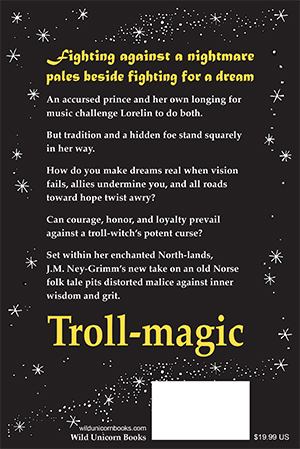 I’m a writer, but I’m also a reader. I’m going to don my reader cap for a moment.
I’m a writer, but I’m also a reader. I’m going to don my reader cap for a moment.
How do I choose my reading material?
When I’m lucky, a friend recommends something that’s right, but my voracity has exhausted most of my friends’ reading lists. (Grin!) More often, I must browse the shelf of new books at the library, check what my favorite authors are reading (because I’ve read all their stories), or fish among Amazon’s recommendations (which are still very hit-or-miss for me).
All these methods, however, eventually confront me face-to-face with a book cover (I’ve blogged about cover design here) and cover copy. Sometimes cover copy might more properly be called web copy, but it’s the same stuff. That cover copy – even on the tail of a friend’s recommendation – must get me to either buy the book outright or flip to the first page of the story. (Which must then make the sale, but story openings are another blog post!)
How does the cover copy do its job? It has an underlying structure. Let’s examine it.
To do so, I’ll doff my reader beret and put my writer fedora back on. How do I write cover copy that lets my readers know this is the story for them?
It isn’t easy. Marketing folk spend years in school learning this skill. But, as an indie publisher, I must manage somehow. The better I communicate the essence of my story, the more of my fans and potential fans will realize they want to read it.
Several months ago I blogged about the two most essential elements of cover copy: theme (not plot) and active verbs. If you missed that post, you’ll find it here. But what about the nitty-gritty, nuts-and-bolts of writing such copy? Theme and active verbs are necessary, but not sufficient for the job. What about the rest?
At the same workshop where I learned to aim for the story’s heart and to avoid all forms of the verb to be, I also learned six questions to ask myself before I sat down to create cover copy. Read on!
What is the theme of the story, and what are the repercussions of this central idea?
This is the big reason a reader wants to read! Is the story about star-crossed lovers, mistaken identity, catching a dream, or what? Spell it out, but don’t descend into your plot. Stay with the big ideas; avoid the finicky details.
Who is the story about?
Readers are people, and people relate to people. Even if your setting is as spectacular as Niven’s Ringworld or your plot as dazzling as Willis’ time travel stories, it is your protagonist who will lead your reader into and through the magic of your creation. If your story has multiple points of view, pick the character who will best snag your reader’s interest.
What is the initial conflict?
Again, do not list plot details. What is the heart or essence of this conflict? Focusing on theme helps you avoid spoilers. You want to give a sense of the story without revealing elements best encountered within it.
Where is the story set?
Ground the reader somewhere. In Chicago’s loop, Virginia’s Blue Ridge, or the troll-infested North-lands. (Grin!) Imagine your reader as a helium balloon: tie his or her string to something. One word might be enough. Other stories will require a phrase or an entire sentence.
What is your tag line?
Developing tag lines probably deserves its own blog post! You’ll need a tag line for your cover copy, and it should possess zip or else drench your reader in evocative images. It usually appears at the end of the cover copy, but sometimes works better at the beginning. Either is fine. When I’m developing a tag line, I try to express the essence of the story as concisely as possible and then pair it with its opposite. I’ll give examples below.
What is the hook?
A hook provokes tension in the reader; it’s often a question. Such as: how can he convince her, when she won’t even talk to him? Will her gift for improv poetry be enough to catch the god’s eye? Can he run fast enough, leap high enough, drink deep enough to surmount the walls of Olympus?
I follow this outline each time I must write copy for an upcoming release. Occasionally I become fired with inspiration after tackling just a few questions and dive in. More often I need four or five answers complete before I start wrestling. Cover copy remains a challenging arena for me! It doesn’t come naturally. I trust continued practice will help!
With that caveat (you’ll want to better my performance), I’ll lead you through my exact progression of thought as I wrote cover copy for four of my stories. I need concrete examples myself, so I’m providing them for you.
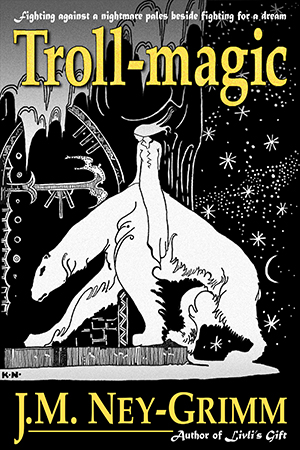 What are the themes in Troll-magic?
What are the themes in Troll-magic?
Dreaming big dreams. Looking beyond your origins. Stretching for more, even when you don’t know quite what more is.
Who is the story about?
Lorelin, a seventeen-year-old growing up in rural Silmaren.
What is the initial conflict?
Lorelin’s family wants her to settle down and commit to life on the family farm. Lorelin wants more, but she’s not sure how to do something different from what her parents have done.
Where does the story take place?
The primary location is Silmaren, the cool northern country where Lorelin lives and where Kellor is imprisoned. The story visits other locations in the North-lands, but only for short periods of time.
Tag line?
Lorelin has dreams – dreams of playing her flute every day, dreams of a larger life. Mandine, the antagonist, is a nightmare come true.
nightmare versus dream
Fighting against a nightmare
Fighting for a dream
Fighting against a nightmare pales beside fighting for a dream.
Hook?
Lorelin doesn’t know what to do, because she can’t see clearly. Her friends and family cannot help her, because they don’t know how either. Her father actively undermines her. And once she’s in the palace, everything goes wrong. It seems there’s no hope left.
Cover Copy
Fighting against a nightmare pales beside fighting for a dream.
An accursed prince and her own longing for music challenge Lorelin to do both.
But tradition and a hidden foe stand squarely in her way.
How do you make dreams come true when vision fails, allies undermine you, and all roads toward hope twist awry?
Can courage, honor, and loyalty prevail against a troll-witch’s potent curse?
Set within her enchanted North-lands, J.M. Ney-Grimm’s new take on an old Norse folk tale pits distorted malice against inner wisdom and grit.
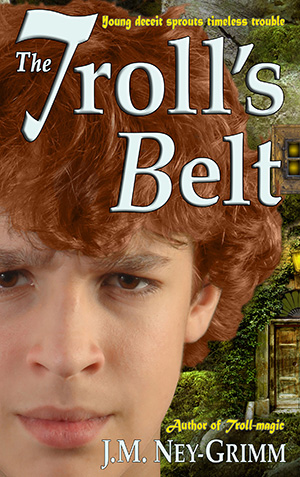 Theme for The Troll’s Belt?
Theme for The Troll’s Belt?
Avoiding full responsibility for yourself by avoiding self-honesty.
Who?
Young Brys Arnson, a 12-year-old, who lives with his father. (His aunt and uncle, right next door, help out.)
Conflict?
Brys means well, but he’s taking short cuts. The result of his dishonesty and skimming out of chores: he gets grounded. When grounded, he cheats again and becomes inadvertent bait for a troll.
Setting?
A lumber-focused hamlet in the frontier lands west of settled Silmaren, where the pine forests and chains of lakes go on forever.
Tag line?
cheat – cheater
trick – trickster – trickery
devour
honesty
Inspiring example from Charmed Life by Diana Wynne Jones: A new witch learns old magic. Tension of opposites: new/old
Ryndal pretends to be friendly. Brys pretends to be trustworthy and responsible. Brys pretends to be strong after he finds the belt.
One pretense too many
When strength is one pretense too many [problem: is]
When stolen strength is one pretense too many [there it is again: is!]
borrowed belt, stolen strength
When wriggling out wriggles you into a heap of trouble.
When a greater cheater traps a lesser, there is no wiggle room.
Wriggling out wriggles Brys into a whole heap of trouble.
Wriggling out – from chores, from losing, from consequences
Wriggling out means wriggling in – to consequences.
Some mistakes are water under the bridge. Other mistakes
A short cut becomes the long way home. [There’s that pesky verb to be.]
A troll and his hunger turn a short cut long.
Short cuts + mistake + one troll = trouble
Short cuts, pretense, and wriggling out yields . . . trouble.
Childish deceit sprouts grownup trouble.
Minor deceit sprouts major trouble.
Young deceit sprouts timeless trouble.
Cover Copy
Motherless Brys Arnson digs himself into trouble. Bad trouble.
Grounded for sneaking and sassing, he makes bad worse.
Now he must dig for courage and honesty to deliver himself and his best friend from his mortal mistake.
Tricked by a troll in J.M. Ney-Grimm’s richly imagined North-lands, Brys must dig himself and his best friend back out of danger. But that requires courage . . . and self-honesty. Traits Brys lacks at depth.
A twist on a classic, The Troll’s Belt builds from humor-threaded conflict to white-knuckle suspense.
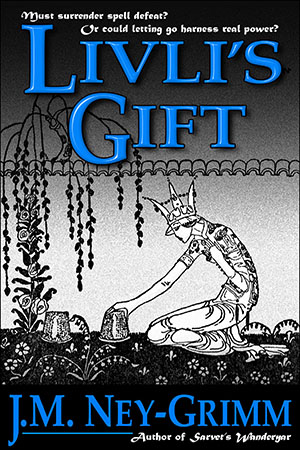 Theme for Livli’s Gift?
Theme for Livli’s Gift?
How to manage cultural change.
Who?
Livli, a young healer in the Hammarleeding spa.
Conflict?
Thoivra wants less contact with the Hammarleeding men and fewer visits between the sister-lodges and brother-lodges. Livli wants exactly the opposite.
Setting?
The Hammarleeding culture in the Fiordhammar mountains of Silmaren. Specifically, Kaunis-lodge, a sister-lodge that is special due to its healing hot spring.
Tag line?
Sometimes letting go spells defeat – sometimes it harnesses power.
Can letting go harness power? Or does it spell defeat?
Does letting go spell defeat? Or does might it harness power?
Does surrender spell defeat? Or might could letting go harness elemental real power?
Must surrender spell defeat? Or could letting go harness real power?
Hook?
Working toward what she wants, could Livli lose everything instead? While Livli pushes forward, one influential sister pushes back.
Livli, being a pioneer in the healing arts, wants change elsewhere as well, in all of living. But her desired change is too big, too much, too fast for her sisters.
Cover Copy
Livli heals the difficult chronic challenging injuries among patients of pilgrims to Kaunis-spa. Its magical spring gives her an edge, but Livli wields a possesses a special gift achieves results that others cannot achieves spectacular cures mainly because she refuses to fail.
A pioneer, she hopes to match new ways of living to her new ways of banishing illness her new ways of banishing hurt with new ways of living.
But her the sisters of Kaunis-lodge fear rapid change. While Livli pushes the new, one influential sister pushes the old. What precious things might they lose while tossing old inconveniences?
Livli pushes forward the new, and one influential foe pushes back. Kaunis-home will keep its revered traditions, even if Livli loses almost everything.
Everything . . . and the one thing she absolutely cannot lose.
Livli seeks an answer in the oldest lore of her people, something so old, it’s new. But mere resolve against failure meets an immovable counterforce this time. Victory requires more.
Must surrender spell defeat? Or could letting go harness real power?
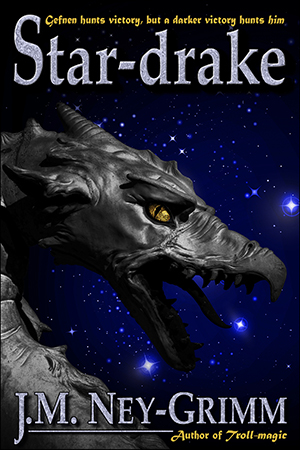 Theme for Star-drake?
Theme for Star-drake?
Rebirth and redemption.
Who?
Gefnen, a troll-herald for a greater troll-lord, Koschey the Deathless.
Emrys, brother to the king of a small island realm.
Conflict?
Gefnen is hunting the life force of a youngster to feed his master, who requires it to hold death at bay. The boy at risk is defended by his friends.
Setting?
The wild moors west of Silmaren (in the North-lands).
Tag line?
redemption – victory – loss
What will victory look like? And to whom will it come?
When does victory mirror loss?
Gefnen hunts victory, but a different victory – redemption? – hunts him.
Gefnen seems to be winning until the star-drake seizes him. Then he seems to be losing. Ultimately he is reborn, and his deep descent into evil will permit him to offer redemption to others. He will know, because he has been there.
possess – hold – mirror – own
Victory mirrors loss until
Boy versus troll versus redemption’s champion.
The stars foretell victory – the night behind them brings something else.
Hunting victory, accepting something else.
Gefnen hunts victory, but victory hunts him.
When victory arrives
Gefnen hunts victory, but a different victory hunts him.
Gefnen hunts victory, but a darker victory hunts him.
First Draft
Gefnen is hunting [pesky to be] hunts life.
Not deer, not pheasant, not game [reserve for later] meat for the table. His master eats choicer fruits.
When the piercing scent of youthful life exuberance tingles in his troll deformed twisted senses, Gefnen tracks focuses the his chase. The boy His prey lacks guardians strong enough to best a troll.
But Gefnen But other seekers than Gefnen tilt the chances in this game. The spirit of the storm, the poignant memories of a seolh-prince, and the vast powers of an ancient star-drake define the shaping looming conflict.
What will victory look like? And to whom will it come?
[You’ll note I have a decided and unfortunate tendency to gild the lily. Luckily I wield a red pen with enthusiasm.]
Cover Copy
Gefnen – troll-herald and hound for Koschey the Deathless – hunts life across the moors of the far north.
Not deer, not pheasant, not meat for the table. His master eats choicer fruits.
When the piercing scent of youthful exuberance youth tingles his senses, Gefnen focuses his chase. This The prey – a boy – lacks guardians strong enough to best a troll. Gefnen readies for Swift victory [reserve for later] triumph awaits.
But other seekers tilt the chances of this game. Spirit of storm, poignant memories of a sea-prince, and something more ancient than memory or the wind shape the looming tumult.
Gefnen hunts victory, but a darker victory hunts him.
Are you a reader? Have you ever chosen a read purely because of its cover copy? What book was it? I’d love to read it myself and learn.
Are you an indie author? What methods do you use to generate effective cover copy? I’d love to learn anything you’d care to share!
For more discussion of cover copy, see my earlier post – Eyes Glaze Over? Never! – on the subject.

Pingback: Erik Robert Nelson | Writing cover copy…
I’m copying our conversation over here from the Passive Voice blog, so your readers know what’s going on. I’ve offered to tackle a rewrite of one of your blurbs so we can see how two different people might tackle the same subject:
KS: “Why don’t you choose one, and we can continue the conversation over on your blog…You already have some great back cover copy, and know what you’re doing, so it would be hard to improve on it, but I do like a challenge now and then!”
JM: That would be really fun! (At least, for me! I’ll trust you on the you-fun part. Love to have the conversation on my blog where others can see it too.)
How about Troll-magic?
Looking forward to it, Kat!
I just recently heard someone say they are not at all influenced by cover copy , and never read it. I wonder. For me it’s cover, copy, first pages, then a purchase decision. If the author hasn’t written sell copy that will make me excited to read the first page, I’m usually on to something else pretty quickly.
Of course a writer can write a good book, put a lovely cover on it, and write terrible cover copy, and I wonder how many potential readers won’t explore any further? I hope many, many indie author/publishers read this article, J.M., and profit thereby.
Thank you, Bridget. Glad you approve!
Back in the day of wire racks that held the books face out (I miss those wire racks!), I learned to skip the cover copy. It always made me want to drop the book immediately! So my purchases proceeded thusly: cover-first page-buy (or not). Just think if I now had decades of reading cover copy under my belt. If only! These days I read cover copy: playing catch-up on my own education. Many readers do use cover copy as part of their purchase decisions, and I’d like them to consider reading my stories!
Just wanted to say this article really helped me put the wheels in motion in my head, in regards to ‘cover’ copy for my WIP. So, thanks! Here’s a cover copy sample that I had squirreled away and liked:
From Little, Big by John Crowley:
John Crowley’s masterful Little, Big is the epic story of Smoky Barnable, an anonymous young man who travels by foot from the City to a place called Edgewood – not found on any map – to marry Daily Alice Drinkwater, as was prophesied. It is the story of four generations of a singular family, living in a house that is many houses on the magical border of an otherworld. It is a story of fantastic love and heartrending loss; of impossible things and unshakable destinies; and of the great Tale that envelops us all. It is a wonder.
PS – nice to see a fellow black-and-white line art enthusiast as well 🙂
Sounds good, Christian. Glad you’re moving ahead.
Engine Summer by John Crowley was one of my favorite reads and has stood up well under re-reading. I remember I also loved his The Deep, but although it was enjoyable upon re-reading it didn’t hold quite the wonder I felt on first reading it. Undoubtedly the change was in me: a touch jaded now; wasn’t in my twenties. I read Little, Big back then, too. I didn’t like it as well. Perhaps it’s time to re-read. Age (my own) might improve my experience. Thanks for posting the cover copy to it. That will be worth some analysis.
And…yes, I love black-and-white line art, especially compositions with art nouveau or art deco influences.
It took me two tries to get into Little, Big. But then, for me, that was true for Lord of the Rings as well. I just had to let myself adjust to the pace of the story instead of trying to race ahead (LOTR… ARE THEY EVER GOING TO GET THERE? ha ha, well, yeah, three books later…) I haven’t picked up anything else by John Crowley but I think it’s high time I remedied that.
Pingback: No Wasted Ink Writer’s Links « No Wasted Ink
What a great post! You give excellent advice on how to write cover blurbs (pitches), and your examples are spot on, and interesting as well.
I really like your take on writing blurbs based on the theme and characters of a story. Far too many writers try to condense the plot of their story into the blurb, and it usually backfires. If the story is good, the plot will be complex, and there’s just no way to condense it without chopping it off. The result is usually a forced account of some events, and the blurb loses it’s snap, and its voice.
Sticking to the theme — aka the core problem of the story, and what it leads up to — and giving the blurb movement by describing the inciting incident is definitely the better way to go.
Thank you very much for a great post, J.M.!
Thanks, Vero!
I like your point about copy movement. I’d missed that perception until you articulated it, and I think it’s important. I’ll be releasing a new story soon – Perilous Chance – and plan to tackle its cover copy soon. I’m going to keep your movement concept in mind as I draft it.
I read this, bookmarked it, and went back to writing. Now Pride’s Children is finished, and I’m getting back to your sage advice – with examples.
I notice that traditional publishers seem to fill up the top of their blurb/description space with whatever quotes they have from other, preferably famous, authors – you get to the actual description lower down, often only after you click Show More.
I don’t care a hoot who recommends a book – unless I am fond of that author. I suppose that would work if the other author and the book being recommended are in the same genre. Though sometimes that quote will be a marvel of economical description, it isn’t always so.
As a newbie, I will not be getting famous authors’ shilling for me, so I need to do a good job on my own, and this is all very thought-provoking. I’m looking forward to taking your ideas, and making them mine while writing my own description.
Thanks for being so generous with what has worked for you.
I include review excerpts in my blurbs, but at the end of the blurb, not the beginning.
I chose excerpts that bring out an element of my story likely to appeal to the type of readers who enjoy my books.
I emphasize content over celebrity-appeal. 😉
Pingback: Cover Copy Primer | Ruth Nestvold – Indie Adventures